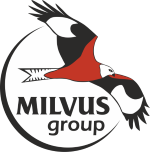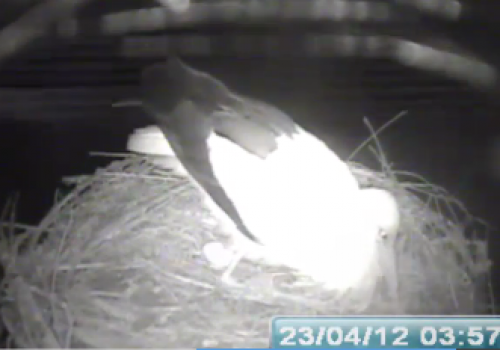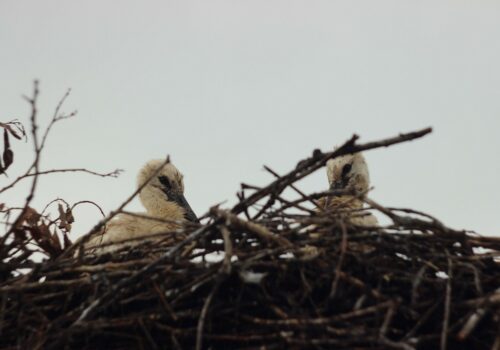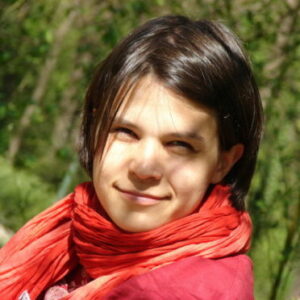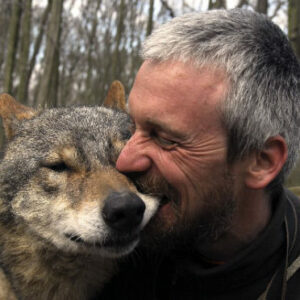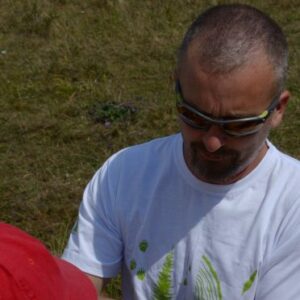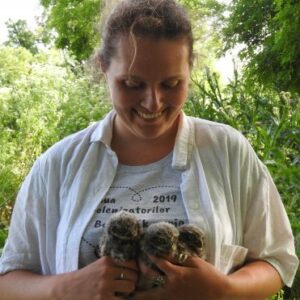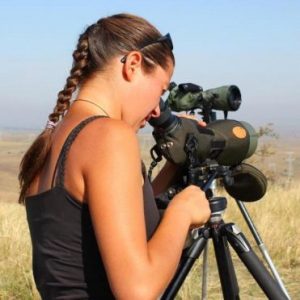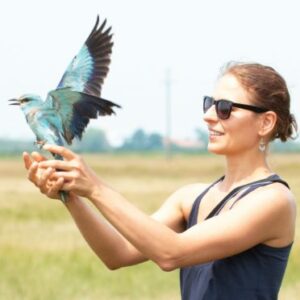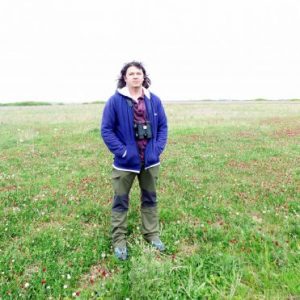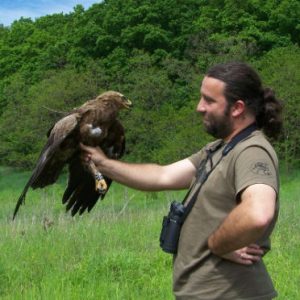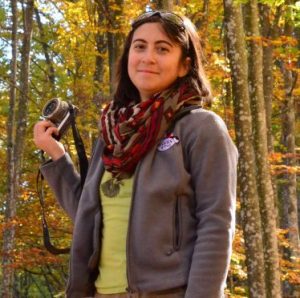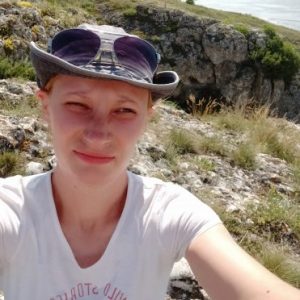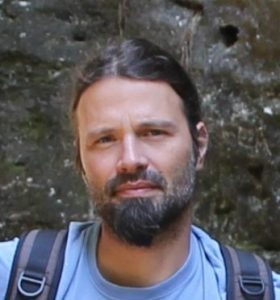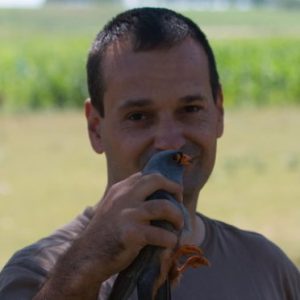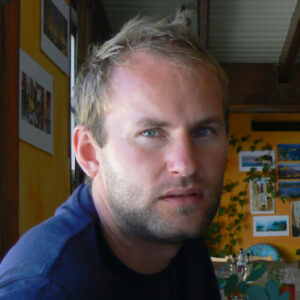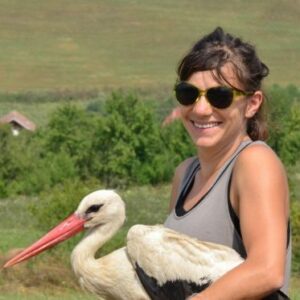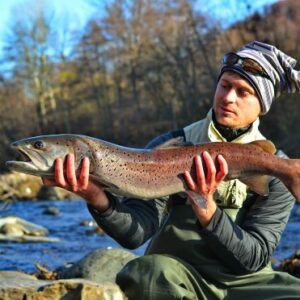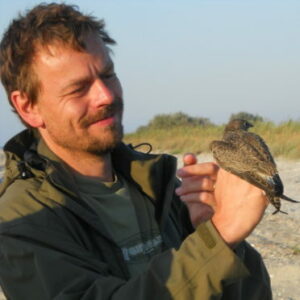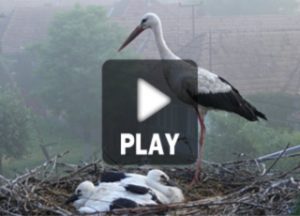 In 2006 “Milvus Group” Bird and Nature Protection Association installed the first web camera on a stork nest in Dumbrăvioara. At first the events from the nest could be followed only on the computer from the stork museum. From 2010 the daily life of the storks in the nest number 10 can be followed anywhere on the world using the internet.
During five years the male from the stork pair who occupied this nest, was a ringed bird (https://milvus.ro/white-storks-with-coloured-elsa-ring/66), but this year the events in the nest were much more exciting. On the 3rd of April a stork came to the nest and on the 8th of April his or her pair arrived too. The first egg was laid on the 19th of April and the next ones on the 21th and 23th of April. The male didn’t take part in the incubation so the female started incubating the three eggs alone.
Surprisingly enough, on the night of 27th the female stork threw out the eggs from the nest. The reason for this is hard to explain. As the male didn’t take part of in the incubation, the female had to stay on the eggs and she didn’t had time to look for food, thus realising that she couldn’t raise the chicks by herself. Another possible explication would be that maybe the eggs were infertile.
In the next day the web camera has transmitted interesting things: a male stork appeared in the nest and started a new brood with the female, this time the male also took part of incubation. The female laid the first egg from the second brood on the 13th May and the second egg was laid on the 15th. After a month of brooding the first egg hatched on the 13th of June. The two adult stork brought food alternately for the chicks, until they grew up and they could go searching for food with their parents. Around 26-27th August the storks left nest number 10 from Dumbrăvioara. Before the long road the storks gather in groups, they feed and roost together.
Although the brooding this year started with failure and a second brood in the same year seemed unfortunate, ultimately the adult and also the juvenile storks, could leave to Africa before the cold months arrived.
The aim of Milvus Group for next year is to install a night-vision camera, so the storks could be followed in the dark too.
In 2006 “Milvus Group” Bird and Nature Protection Association installed the first web camera on a stork nest in Dumbrăvioara. At first the events from the nest could be followed only on the computer from the stork museum. From 2010 the daily life of the storks in the nest number 10 can be followed anywhere on the world using the internet.
During five years the male from the stork pair who occupied this nest, was a ringed bird (https://milvus.ro/white-storks-with-coloured-elsa-ring/66), but this year the events in the nest were much more exciting. On the 3rd of April a stork came to the nest and on the 8th of April his or her pair arrived too. The first egg was laid on the 19th of April and the next ones on the 21th and 23th of April. The male didn’t take part in the incubation so the female started incubating the three eggs alone.
Surprisingly enough, on the night of 27th the female stork threw out the eggs from the nest. The reason for this is hard to explain. As the male didn’t take part of in the incubation, the female had to stay on the eggs and she didn’t had time to look for food, thus realising that she couldn’t raise the chicks by herself. Another possible explication would be that maybe the eggs were infertile.
In the next day the web camera has transmitted interesting things: a male stork appeared in the nest and started a new brood with the female, this time the male also took part of incubation. The female laid the first egg from the second brood on the 13th May and the second egg was laid on the 15th. After a month of brooding the first egg hatched on the 13th of June. The two adult stork brought food alternately for the chicks, until they grew up and they could go searching for food with their parents. Around 26-27th August the storks left nest number 10 from Dumbrăvioara. Before the long road the storks gather in groups, they feed and roost together.
Although the brooding this year started with failure and a second brood in the same year seemed unfortunate, ultimately the adult and also the juvenile storks, could leave to Africa before the cold months arrived.
The aim of Milvus Group for next year is to install a night-vision camera, so the storks could be followed in the dark too.
The 2011 events in the stork nest with web camera
 In 2006 “Milvus Group” Bird and Nature Protection Association installed the first web camera on a stork nest in Dumbrăvioara. At first the events from the nest could be followed only on the computer from the stork museum. From 2010 the daily life of the storks in the nest number 10 can be followed anywhere on the world using the internet.
During five years the male from the stork pair who occupied this nest, was a ringed bird (https://milvus.ro/white-storks-with-coloured-elsa-ring/66), but this year the events in the nest were much more exciting. On the 3rd of April a stork came to the nest and on the 8th of April his or her pair arrived too. The first egg was laid on the 19th of April and the next ones on the 21th and 23th of April. The male didn’t take part in the incubation so the female started incubating the three eggs alone.
Surprisingly enough, on the night of 27th the female stork threw out the eggs from the nest. The reason for this is hard to explain. As the male didn’t take part of in the incubation, the female had to stay on the eggs and she didn’t had time to look for food, thus realising that she couldn’t raise the chicks by herself. Another possible explication would be that maybe the eggs were infertile.
In the next day the web camera has transmitted interesting things: a male stork appeared in the nest and started a new brood with the female, this time the male also took part of incubation. The female laid the first egg from the second brood on the 13th May and the second egg was laid on the 15th. After a month of brooding the first egg hatched on the 13th of June. The two adult stork brought food alternately for the chicks, until they grew up and they could go searching for food with their parents. Around 26-27th August the storks left nest number 10 from Dumbrăvioara. Before the long road the storks gather in groups, they feed and roost together.
Although the brooding this year started with failure and a second brood in the same year seemed unfortunate, ultimately the adult and also the juvenile storks, could leave to Africa before the cold months arrived.
The aim of Milvus Group for next year is to install a night-vision camera, so the storks could be followed in the dark too.
In 2006 “Milvus Group” Bird and Nature Protection Association installed the first web camera on a stork nest in Dumbrăvioara. At first the events from the nest could be followed only on the computer from the stork museum. From 2010 the daily life of the storks in the nest number 10 can be followed anywhere on the world using the internet.
During five years the male from the stork pair who occupied this nest, was a ringed bird (https://milvus.ro/white-storks-with-coloured-elsa-ring/66), but this year the events in the nest were much more exciting. On the 3rd of April a stork came to the nest and on the 8th of April his or her pair arrived too. The first egg was laid on the 19th of April and the next ones on the 21th and 23th of April. The male didn’t take part in the incubation so the female started incubating the three eggs alone.
Surprisingly enough, on the night of 27th the female stork threw out the eggs from the nest. The reason for this is hard to explain. As the male didn’t take part of in the incubation, the female had to stay on the eggs and she didn’t had time to look for food, thus realising that she couldn’t raise the chicks by herself. Another possible explication would be that maybe the eggs were infertile.
In the next day the web camera has transmitted interesting things: a male stork appeared in the nest and started a new brood with the female, this time the male also took part of incubation. The female laid the first egg from the second brood on the 13th May and the second egg was laid on the 15th. After a month of brooding the first egg hatched on the 13th of June. The two adult stork brought food alternately for the chicks, until they grew up and they could go searching for food with their parents. Around 26-27th August the storks left nest number 10 from Dumbrăvioara. Before the long road the storks gather in groups, they feed and roost together.
Although the brooding this year started with failure and a second brood in the same year seemed unfortunate, ultimately the adult and also the juvenile storks, could leave to Africa before the cold months arrived.
The aim of Milvus Group for next year is to install a night-vision camera, so the storks could be followed in the dark too.
